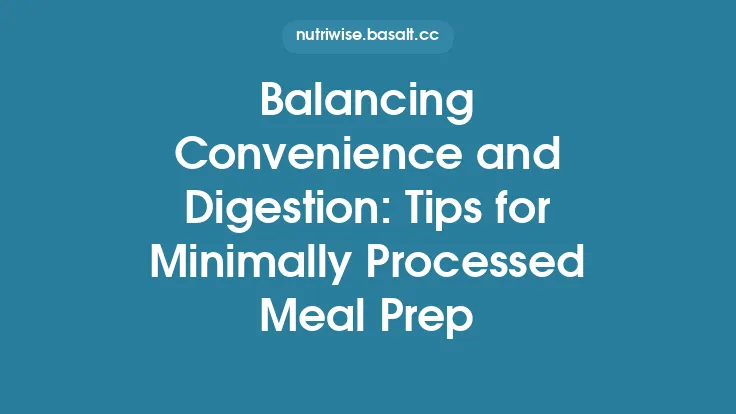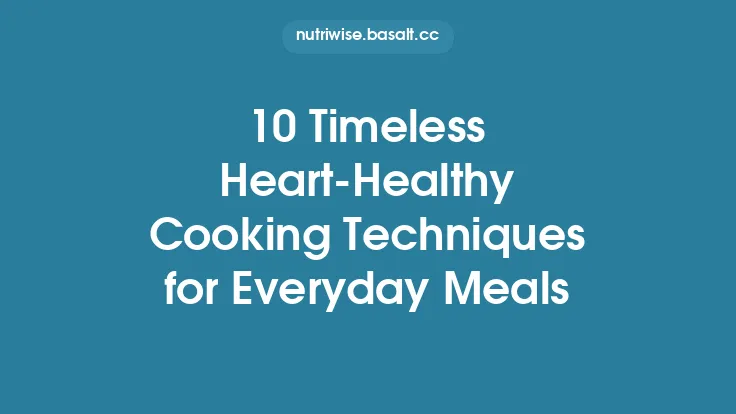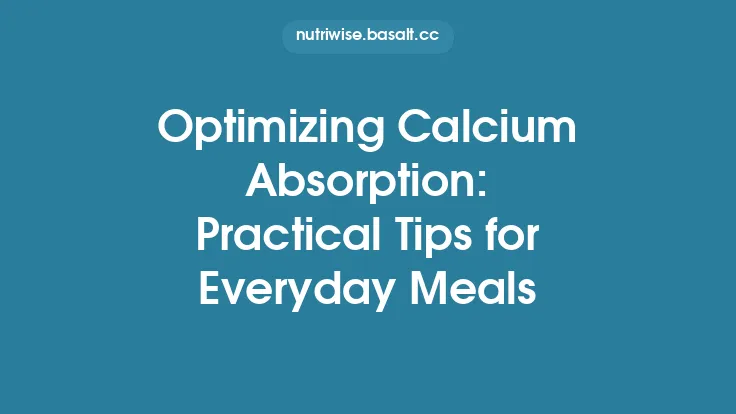When it comes to protecting your cardiovascular system, the foods you choose to place on your plate can be just as important as the cooking methods you employ. While many heart‑healthy cooking guides focus on the right fats, sodium levels, or portion control, one of the most powerful—and often overlooked—strategies is simply reducing the amount of processed food that makes its way into your meals. By shifting the balance toward whole, minimally altered ingredients, you give your heart the cleanest possible fuel, lower exposure to hidden additives, and more control over the nutritional profile of every dish.
Understanding What Counts as Processed Food
The term “processed” covers a broad spectrum, from lightly washed and cut vegetables to heavily refined, pre‑packaged meals. For the purpose of heart‑healthy cooking, it helps to categorize foods into three tiers:
| Tier | Description | Typical Examples |
|---|---|---|
| Minimally Processed | Foods that have been cleaned, peeled, or portioned but retain their natural composition. | Fresh produce, frozen peas, plain yogurt, raw nuts. |
| Moderately Processed | Items that have added ingredients for preservation, flavor, or convenience, yet still retain a recognizable base food. | Canned beans (with added salt), whole‑grain breads, smoked salmon, pre‑cut fruit packs. |
| Highly Processed | Products that undergo multiple manufacturing steps, often containing additives, refined grains, sugars, and unhealthy fats. | Packaged snack cakes, instant noodles, sugary breakfast cereals, deli meats, frozen pizza. |
Understanding these tiers allows you to make intentional choices about which items to keep in your pantry and which to replace with fresher alternatives.
Why Reducing Processed Foods Benefits Heart Health
- Lower Exposure to Additives
Many highly processed foods contain emulsifiers, artificial sweeteners, and preservatives (e.g., sodium benzoate, BHT) that have been linked in research to inflammation and endothelial dysfunction—both precursors to atherosclerosis.
- Improved Nutrient Density
Processing often strips away fiber, vitamins, and minerals while concentrating calories. Whole foods provide a richer matrix of micronutrients, phytochemicals, and soluble fiber that support lipid profiles and blood pressure regulation.
- Better Control Over Sodium and Sugar
Even if you’re not focusing on sodium reduction per se, it’s worth noting that processed items are a primary source of hidden salt and added sugars, which can raise blood pressure and triglyceride levels over time.
- Reduced Trans‑Fat and Unhealthy Saturated Fat
Many packaged baked goods and fried snacks contain partially hydrogenated oils, a known risk factor for coronary artery disease.
- Stabilized Blood Glucose
Refined grains and added sugars cause rapid spikes in blood glucose, prompting insulin surges that can contribute to metabolic syndrome—a cluster of conditions that heighten heart disease risk.
Start with a Kitchen Inventory: Identifying Hidden Processors
Before you can eliminate processed foods, you need to know what’s already in your kitchen. Follow these steps:
- Create a List – Write down every item in your pantry, fridge, and freezer. Include condiments, sauces, and “quick‑prep” meals.
- Classify by Tier – Assign each product to one of the three processing tiers described above.
- Flag the Culprits – Highlight highly processed items that appear frequently (e.g., canned soups, flavored rice mixes, pre‑made dressings).
- Set a Removal Goal – Decide on a realistic timeline (e.g., 30 days) to phase out the flagged items, replacing them with whole‑food equivalents.
A systematic inventory not only reveals the hidden sources of processed ingredients but also provides a clear roadmap for gradual improvement.
Smart Shopping Strategies for Whole, Unprocessed Ingredients
- Shop the Perimeter First
The outer aisles of most grocery stores house fresh produce, meats, dairy, and bulk nuts—items that are typically less processed. Make these sections the foundation of your cart.
- Read Labels Like a Scientist
- Ingredient Count: Fewer ingredients usually mean less processing.
- Identify Additives: Look for terms ending in “‑ate,” “‑ite,” “‑ol,” or “‑ine” (e.g., sodium nitrate, monosodium glutamate).
- Check for Whole‑Food Claims: Phrases like “made with whole grains” can be misleading; verify the first ingredient.
- Choose Bulk Over Packaged
Buying grains, legumes, and nuts in bulk reduces exposure to preservatives and allows you to control portion sizes.
- Prioritize Fresh or Frozen Without Additives
Frozen vegetables are often flash‑frozen at peak ripeness and contain no extra salt or sauces—making them an excellent alternative to canned varieties.
- Opt for Simple Condiments
Instead of pre‑made sauces that contain sugar, corn syrup, or artificial flavors, select basic ingredients (e.g., olive oil, lemon juice, fresh herbs) that you can combine at home.
Batch Cooking and Freezing: Building a Ready‑to‑Use Pantry
One of the biggest temptations to reach for processed foods is convenience. By preparing staple components in bulk, you can replicate that convenience without compromising nutrition.
| Batch‑Cooked Component | How to Prepare | Storage Tips |
|---|---|---|
| Whole‑Grain Pilaf | Cook quinoa, brown rice, or farro with low‑sodium broth and aromatics. | Portion into airtight containers; freeze for up to 3 months. |
| Legume Bases | Simmer lentils, chickpeas, or black beans with bay leaf and garlic. | Cool, portion, and store in the fridge for 5 days or freeze for longer use. |
| Vegetable Roasts | Toss a mix of root vegetables, cruciferous florets, and peppers with olive oil and herbs; roast at 425°F (220°C) until caramelized. | Store in the fridge; reheat as a side or blend into soups. |
| Homemade Stock | Simmer bones, vegetable scraps, and aromatics for 6–8 hours; strain. | Freeze in ice‑cube trays for easy portioning. |
Having these building blocks on hand means you can assemble a balanced meal in minutes—no need to resort to a microwaveable processed entrée.
Homemade Substitutes for Common Processed Items
| Processed Item | Homemade Alternative | Key Benefits |
|---|---|---|
| Store‑Bought Salad Dressing | Whisk together extra‑virgin olive oil, balsamic vinegar, Dijon mustard, and a pinch of sea salt. | No added sugars or preservatives; customizable fat content. |
| Flavored Rice Mixes | Cook brown rice with low‑sodium broth, add sautéed onions, garlic, and a handful of frozen peas. | Retains fiber and reduces sodium. |
| Pre‑Made Marinades | Blend soy sauce (or tamari), fresh ginger, garlic, and a splash of citrus juice. | Eliminates hidden MSG and excess sugar. |
| Canned Soups | Simmer a base of homemade stock with diced vegetables, beans, and herbs; blend for a creamy texture if desired. | Full control over sodium, fat, and additive content. |
| Processed Cheese Slices | Slice a block of natural cheese (e.g., cheddar, mozzarella) yourself. | Avoids emulsifiers and excess sodium. |
These swaps require a modest time investment but pay dividends in nutritional quality and flavor authenticity.
Flavor Without Additives: Using Natural Techniques
Even without processed flavor enhancers, you can achieve depth and excitement in your dishes:
- Umami Boosters: Incorporate mushrooms, tomatoes, or a splash of low‑sodium soy sauce to naturally enhance savory notes.
- Acid Balance: A squeeze of fresh lemon or a dash of vinegar can brighten flavors, reducing the need for added salt.
- Texture Contrast: Toasted nuts, seeds, or a quick sauté of garlic can add crunch and aromatic complexity.
- Layered Cooking: Begin with aromatics (onion, garlic, ginger), add vegetables, then finish with herbs at the end of cooking to preserve freshness.
By mastering these techniques, you’ll find that processed flavor packets become unnecessary.
Mindful Meal Prep to Avoid Convenience Traps
- Plan a Weekly Menu – Draft a simple menu that emphasizes whole ingredients. Keep the number of meals manageable (e.g., 3–4 distinct dinner recipes) to avoid overwhelm.
- Prep Ingredients, Not Full Meals – Chop vegetables, portion proteins, and pre‑cook grains on a designated prep day. This approach gives you flexibility while still saving time.
- Use Portion‑Controlled Containers – Store pre‑portioned components in clear containers; visual cues help you stay on track without reaching for a processed snack.
- Keep a “Rescue” Box – Stock a small drawer with quick, whole‑food options (e.g., canned beans with no added salt, plain Greek yogurt, fresh fruit). When time runs short, you have a heart‑friendly fallback.
Gradual Transition: Setting Realistic Goals
Changing long‑standing eating habits can be daunting. Adopt a stepwise approach:
- Week 1–2: Replace one processed item per day (e.g., swap sugary cereal for oatmeal topped with fresh berries).
- Week 3–4: Introduce batch‑cooked staples and use them in at least two meals per day.
- Month 2: Eliminate a specific category of highly processed foods (e.g., processed meats) and replace them with lean, fresh protein sources.
- Month 3: Conduct a second kitchen inventory to assess progress and identify any remaining processed items.
Celebrate each milestone; incremental success builds lasting habits.
Resources and Tools for Ongoing Success
- Nutrition Apps: Use free apps that allow you to scan barcodes and view ingredient lists, helping you spot hidden additives.
- Cookbooks Focused on Whole Foods: Look for titles that emphasize “from scratch” cooking without relying on processed shortcuts.
- Community Groups: Join local cooking clubs or online forums where members share recipes and tips for minimizing processed foods.
- Educational Websites: Government and university nutrition portals often provide databases of whole‑food recipes and guidance on reading food labels.
By integrating these tools into your routine, you’ll maintain momentum and continue to refine your heart‑healthy cooking practices.
Reducing processed foods isn’t a one‑time diet tweak; it’s a sustainable shift toward a cleaner, more transparent kitchen. By understanding what constitutes processing, auditing your pantry, making strategic shopping choices, and mastering simple home‑cooking techniques, you empower yourself to feed your heart with the most nourishing ingredients available. The result is not only a lower risk of cardiovascular disease but also a richer culinary experience—one that celebrates the natural flavors and textures of whole foods, day after day.





